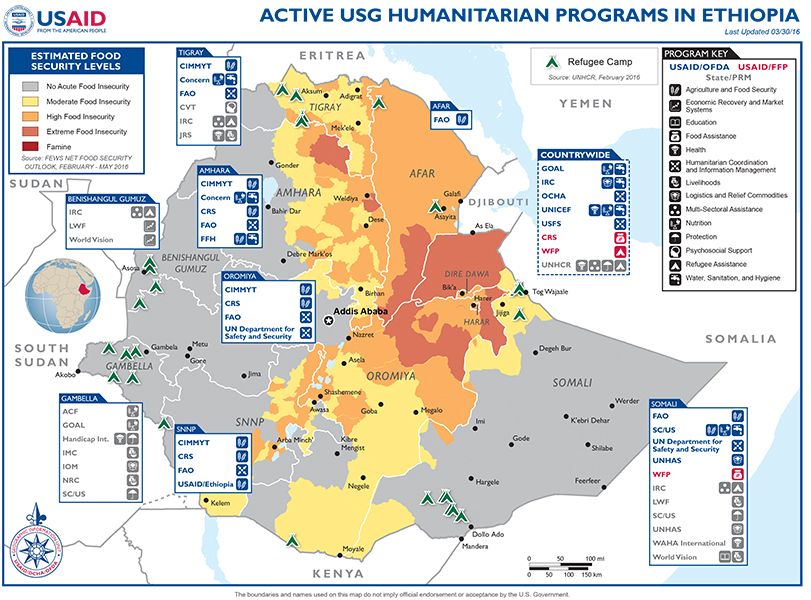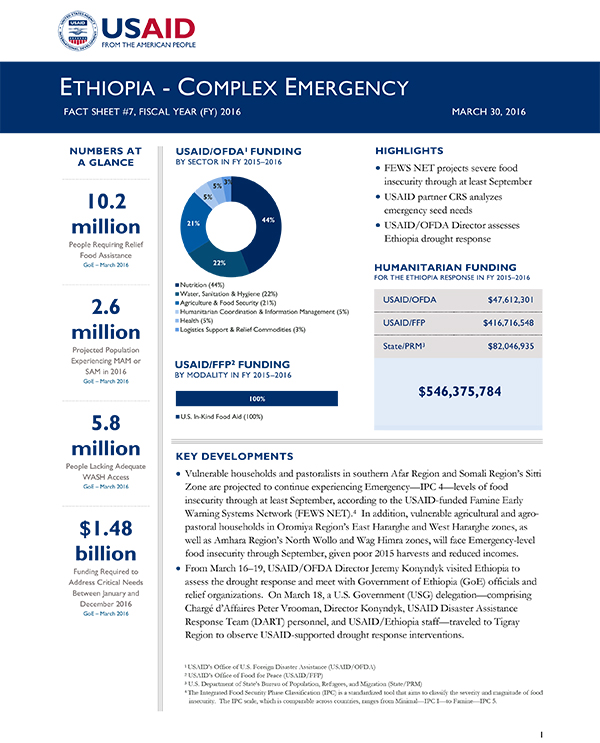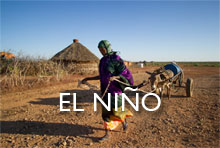- What We Do
- Agriculture and Food Security
- Democracy, Human Rights and Governance
- Economic Growth and Trade
- Education
- Ending Extreme Poverty
- Environment and Global Climate Change
- Gender Equality and Women's Empowerment
- Global Health
- Water and Sanitation
- Working in Crises and Conflict
- Disaster Assistance
- Political Transition Initiatives
- Conflict Mitigation and Prevention
- Countering Violent Extremism
- Disaster Risk Reduction
- Peacebuilding and Reconciliation
- Providing Safe & Secure Environments for Development
- Recovering From Crisis
- Resilience
- Tech Challenge for Atrocity Prevention
- World Humanitarian Day
- U.S. Global Development Lab
March 30, 2016
Highlights
FEWS NET projects severe food insecurity through at least September
USAID partner CRS analyzes emergency seed needs
USAID/OFDA Director assesses Ethiopia drought response
Key Developments
Ethiopia Map - 03-30-2016 ![]() (pdf - 1 MB)
(pdf - 1 MB)
Numbers At A Glance
10.2 million
2.6 million
5.8 million
$1.48 billion
Humanitarian Funding
For the Ethiopia Response
FY 2015 - 2016
| USAID/OFDA | $47,612,301 |
| USAID/FFP | $416,716,548 |
| State/PRM | $82,046,935 |
| TOTAL | $546,375,784 |
Vulnerable households and pastoralists in southern Afar Region and Somali Region’s Sitti Zone are projected to continue experiencing Emergency—IPC 4—levels of food insecurity through at least September, according to the USAID-funded Famine Early Warning Systems Network (FEWS NET). 4 In addition, vulnerable agricultural and agropastoral households in Oromiya Region’s East Hararghe and West Hararghe zones, as well as Amhara Region’s North Wollo and Wag Himra zones, will face Emergency-level food insecurity through September, given poor 2015 harvests and reduced incomes.
From March 16–19, USAID/OFDA Director Jeremy Konyndyk visited Ethiopia to assess the drought response and meet with Government of Ethiopia (GoE) officials and relief organizations. On March 18, a U.S. Government (USG) delegation—comprising Chargé d’Affaires Peter Vrooman, Director Konyndyk, USAID Disaster Assistance Response Team (DART) personnel, and USAID/Ethiopia staff—traveled to Tigray Region to observe USAID-supported drought response interventions.
CURRENT EVENTS
The humanitarian response to drought and widespread needs in Ethiopia remains underfunded, and relief organizations launched a 90-day campaign on March 23 to address urgent funding gaps. The GoE and international partners have provided only approximately $758 million of the more than $1.4 billion requested by the 2016 Humanitarian Requirements Document (HRD), which outlines anticipated humanitarian needs and required funding levels between January and December 2016, according to the UN. The GoE is leading coordination efforts and had contributed at least $381 million in funding for the response as of mid-February.
On March 25, FEWS NET reported that February-to-June belg rainfall has been below-average to date. The onset of belg rains was timely in Southern Nations, Nationalities, and Peoples (SNNP) Region; however, Afar, eastern Amhara, central and eastern Oromiya, and eastern Tigray have experienced delayed and erratic rainfall, exacerbating drought conditions. Despite below-average rain, farmers across Ethiopia are preparing land and planting belg crops, although the percentage of planted land is below-average compared to previous belg seasons due to delayed rainfall and seed shortages. FEWS NET estimates that belg planting is likely to continue through April and May
FOOD SECURITY
In mid-March, FEWS NET released a report projecting likely food security outcomes in Ethiopia through September 2016. According to the report, vulnerable populations in southern Afar and Somali’s Sitti Zone continue to face substantial gaps in basic food needs and deplete household assets due to poor 2015 harvests, drought-related population displacement, significant livestock deaths, and low livestock productivity. Reduced livestock prices are also restricting food access, while low milk availability is adversely affecting acute malnutrition levels among children, according to FEWS NET. Vulnerable households and most pastoralists in affected areas are projected to continue experiencing Emergency levels of food insecurity through at least September. In addition, agricultural and agro-pastoral households in Oromiya’s East Hararghe and West Hararghe zones, as well as Amhara’s North Wollo and Wag Himra zones, will face Emergency-level food insecurity through at least September, given poor 2015 harvests and reduced labor and livestock income.
Populations in much of eastern Amhara and Tigray, central and eastern Oromiya, and northern SNNP will continue to experience Crisis—IPC 3—levels of food insecurity through September, according to FEWS NET. Limited pasture and severe water shortages have resulted in livestock deaths and poor body conditions, reducing incomes among drought-affected populations. Elevated staple food prices have further exacerbated food access gaps and accelerated household asset depletion. Without continued humanitarian assistance, FEWS NET projects that some droughtaffected households experiencing Crisis-level food insecurity may deteriorate to Emergency levels of food insecurity during the peak lean season from June–September.
From March 2–9, USAID/FFP staff assessed humanitarian conditions at the Asaita and Berahle refugee camps in Afar, where the Office of the UN High Commissioner for Refugees (UNHCR) reports that more than 19,000 Eritrean refugees are sheltering. The USAID/FFP assessment found that the food security situation for refugees in Afar had deteriorated due to extended drought conditions. The GoE manages monthly food distributions—comprising cooking oil, pulses, salt, and wheat—for refugees in the camps, although rations only provide food for approximately 20 days. In addition to emergency food assistance, refugees also receive sanitary kits for women and girls, safe drinking water, and soap.
The assessment identified critical needs among refugees in Afar, including inadequate shelter and latrine infrastructure, the absence of psychosocial support services, and lack of fuel sources for cooking. Women in the camps noted walking up to 10 hours to collect firewood, reportedly exacerbating tensions with host communities. In response to assessed gaps, USAID/FFP recommended increasing access to cooking fuel, enhancing shelter infrastructure, improving health care services, and expanding educational programming for refugees.
LOGISTICS
Inadequate logistics capacity—particularly management of substantial increases in relief food assistance—is hindering the drought response in Ethiopia, according to the UN. The relief food assistance system—supporting an average of approximately 3–4 million beneficiaries per year prior to the drought—is currently supporting 10.2 million foodinsecure people; the population requiring relief food assistance will likely increase in the coming months, further exacerbating logistics constraints within Ethiopia.
In addition to logistics challenges in Ethiopia, ongoing congestion at the Port of Djibouti—the primary port handling shipments of emergency relief commodities destined for Ethiopia—is impeding the transport of humanitarian cargo, especially relief food assistance, international media reported. As of March 24, at least 10 vessels containing approximately 450,000 metric tons (MT) of wheat were awaiting berthing at the port. Relief food assistance pipelines may be at risk of temporary breakage over the coming months if humanitarian cargo is not prioritized for berthing at the Port of Djibouti, according to the UN.
In response to significant logistics challenges, the GoE is expanding trucking capacity, building distribution points, and establishing temporary warehouses. The GoE and relief organizations also plan to establish an enhanced logistics mechanism to improve response efficiency, including planning and coordination, information management capacity, and transportation and fleet management.
From March 14–18, a USG interagency logistics team assessed logistics constraints and ongoing congestion at the Port of Djibouti. The assessment found that the inefficient offloading of cargo from berthed ships—partly due to limited truck availability—is one of the most significant logistics challenges at the port.
AGRICULTURE
The GoE and relief actors had provided emergency seed interventions to more than 82,500 households as of March 23, representing nearly 42 percent of the more than 198,000 targeted households for the belg planting season, according to the UN. An additional 51,400 household—approximately 3 percent of the 1.7 million targeted households—had received seeds for the meher planting season ending in May. On March 21, the UN reported that approximately $60 million was urgently needed to fund meher emergency seed interventions.
From March 12–15, GoE representatives, USAID partners and other non-governmental organizations (NGOs), public and private seed suppliers, and cooperative farmer unions convened emergency seed meetings in Oromiya, SNNP, and Tigray. The participants discussed drought mitigation efforts, identified seed suppliers and distribution mechanisms, and appointed regional-, zonal-, and woreda-, or district-, level contacts for planning seed distributions and resolving challenges.
In November 2015, USAID partner Catholic Relief Services (CRS) conducted a seed assessment across 17 districts in drought-affected Amhara, Oromiya, SNNP, and Tigray. The assessment identified three seed systems in Ethiopia— formal, semi-formal, and informal. The GoE regulates and supports the formal seed system, including breeding, processing, production, and marketing. The GoE distributes seeds through cooperatives or district-level agricultural offices, while cooperatives, farmers, and entrepreneurs produce seeds as part of the semi-formal system. According to CRS estimates, smallholder farmers primarily source seed from the informal system—reportedly up to 90 percent in some areas.
The CRS assessment found that approximately 72 percent of farmers in assessed areas sourced seed from informal markets during 2015; however, CRS anticipates that fewer farmers in 2016 will acquire seed from informal sources due to below-average 2015 belg and meher harvests. As a result, CRS projects that more than 33 percent of farmers will require emergency seed assistance for crop production in 2016. Relief organizations delivering emergency seed distributions should utilize existing systems and provide seed vouchers, when possible, according to CRS.
NUTRITION AND WASH
Between January and mid-March, the UN World Food Program (WFP) provided targeted supplementary feeding interventions to more than 450,000 children and pregnant and lactating mothers experiencing moderate acute malnutrition (MAM) in 135 nutrition hotspot priority one districts and 8 nutrition hotspot priority two districts.54 The GoE anticipates that WFP will treat approximately 506,000 people experiencing MAM in all 186 nutrition hotspot priority one districts by the end of March.
As of mid-March, at least 900,000 people across six drought-affected regions in Ethiopia—Afar, Amhara, Oromiya, SNNP, Somali, and Tigray—required emergency water-trucking services to meet basic water, sanitation, and hygiene (WASH) needs, according to the GoE Ministry of Water and relief actors. Of the 166 WASH hotspot priority one districts, the GoE was providing emergency WASH interventions services in 105 districts, NGOs were providing WASH assistance in 33 districts, and 28 districts were not receiving emergency WASH assistance as of March 22, according to the WASH Emergency Task Force. Poor infrastructure and distance have reduced water-trucking access to some droughtaffected areas, especially in Amhara.
In response to severe water shortages, the UN Children’s Fund (UNICEF) recently deployed an additional 100 trucks to boost ongoing WASH response efforts, especially in drought-affected Afar. To complement emergency water-trucking assistance, the GoE and relief organizations are supporting long-term water system interventions, including drilling new boreholes and rehabilitating water points.
PROTECTION
The 2016 HRD calls for approximately $11.9 million in protection assistance to support an estimated 2.5 million vulnerable people in Ethiopia during 2016—the first year that the HRD includes protection-specific interventions. The GoE and relief organizations plan to establish and strengthen gender-based violence (GBV) referral pathways, construct female-friendly spaces, distribute post-rape treatment kits, and train more than 2,300 health care workers regarding clinical management of rape, psychosocial support, and GBV case management.
A joint GoE–UNICEF rapid assessment in December 2015 surveyed nearly 1,150 people in Afar, Amhara, Oromiya, Somali, and Tigray regarding drought-related child protection challenges. The final assessment, released in February 2016, found that approximately 83 percent of respondents reported observing separation of children from primary caregivers since July 2015, with approximately 59 percent expressing awareness of unaccompanied children in their community. The report included conflicting data regarding drought-related effects on sexual violence against children. While 80 percent of respondents had not observed an increase in sexual violence, nearly 90 percent reported that girls were at heightened risk of sexual violence due to the drought. Approximately 66 percent of respondents reported that women and children faced sexual violence risks while collecting firewood, with 53 percent noting additional risks while retrieving water.
HUMANITARIAN ASSESSMENTS
During the week of March 21, USAID DART and USAID/Ethiopia staff traveled to Amhara’s Wag Himra Zone to evaluate humanitarian needs among drought-affected populations. The assessment found that the drought has affected approximately 48 percent of the zone, with severe water shortages displacing more than 2,000 households. Water shortages have also reduced pasture and livestock in the zone, particularly in lowland areas. An estimated 35,000 livestock have migrated to Amhara’s North Gonder Zone, while pastoralists have sold more than 200,000 livestock. To mitigate severe water shortages, the GoE is improving access to safe drinking water at schools in the zone by providing vehicles and animals to transport tens of thousands of liters of water to affected populations.
In response to deteriorating humanitarian conditions in Amhara’s South Gonder and Wag Himra zones, Food for the Hungry (FFH)—with $1.5 million in USAID/OFDA support—is providing emergency livestock and WASH assistance to drought-affected populations. In addition, FFH is assisting commercial destocking of livestock, providing animal feed, and supporting livestock migration when necessary. The NGO is also providing water-trucking services to more than 22,500 people in Wag Himra, while the USAID/FFP-supported, CRS-led Joint Emergency Operation (JEOP) is delivering approximately 3,800 MT of emergency food assistance to an estimated 244,000 people in the zone during the first round of 2016 relief food distributions.
CONTEXT
Multiple consecutive seasons of below-normal rainfall—exacerbated by the effects of the El Niño climatic event—have resulted in deteriorating agricultural, livestock, food security, and nutrition conditions in northeastern and central Ethiopia. By February 2016, the GoE estimated that 10.2 million people required relief food assistance and other humanitarian interventions.
USAID activated a DART on February 24, 2016, to lead the USG crisis response to the drought in Ethiopia. Under the strong leadership of the GoE, the DART is coordinating USG response activities in close partnership with the UN and other relief organizations. The DART—composed of humanitarian specialists based in Ethiopia—is addressing critical needs and examining ways to realign activities to respond to urgent assistance gaps. USAID also established an Ethiopia Drought RMT based in Washington, D.C., to support emergency response efforts in Ethiopia.
While drought remains a major contributor to vulnerability in Ethiopia, negatively affecting the lives and livelihoods of farmers and pastoralists, populations also continue to confront other challenges—including seasonal flooding, localized intercommunal conflict, above-average food prices, disease outbreaks, and limited access to health and WASH services—that contribute to sustained humanitarian needs and an ongoing complex emergency in Ethiopia.
On October 7, 2015, U.S. Chargé d’Affaires, a.i., Peter H. Vrooman redeclared a disaster for Ethiopia in response to the ongoing complex emergency.
PUBLIC DONATION INFORMATION
The most effective way people can assist relief efforts is by making cash contributions to humanitarian organizations that are conducting relief operations. A list of humanitarian organizations that are accepting cash donations for disaster responses around the world can be found at www.interaction.org.
USAID encourages cash donations because they allow aid professionals to procure the exact items needed (often in the affected region); reduce the burden on scarce resources (such as transportation routes, staff time, and warehouse space); can be transferred very quickly and without transportation costs; support the economy of the disaster-stricken region; and ensure culturally, dietary, and environmentally appropriate assistance.
More information can be found at:
- USAID Center for International Disaster Information: www.cidi.org or +1.202.821.1999.
- Information on relief activities of the humanitarian community can be found at www.reliefweb.int.










Comment
Make a general inquiry or suggest an improvement.